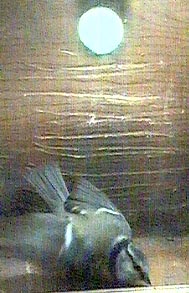The Bird Box Diary |
February 2003 |
Go to last entry of the month....................Go to previous entry2 February - A relatively quiet day in the box today. The female first looked into the box at 8.10am but waited until ten minutes later before she entered. During the rest of the morning she was in the box just another seven times, with the last visit at just before 2.30pm. The male appeared just twice, looking in while has partner was in at 9.47am and again just after 11am. The afternoon had turned cloudy and dull, with rain showers, and perhaps this has discouraged them.
3 February - On a bright sunny, chilly morning it was the male who arrived first, at about 8.20am. As usual he stayed at the entrance, had a few pecks at the wood and left.
In this case a female sparrow (see the light flashes at the side of her head) perched on a branch of the Birch. I could see the Blue Tit looking out and swaying from side to side, beak open in her defensive display. The Sparrow approached and hovered in front of the entrance. The BT responded in her usual way and you can see her, beak wide open as the sparrow retires to the left. These encounters continue to puzzle me. The Sparrows have no interest in the box at all when there is not a Blue Tit inside. These 'attacks' never become more involved than this one has, and they do not seem interested in trying to enter the box. When the incident is over the Blue Tit can carry on with its activities, perhaps for the rest of the day, without further harrasment, even though there are Sparrows about at that end of my garden all day.
While the connections have all proved good, the right hand image illustrates the next problem to be solved. At the moment lighting is provided by a tungsten lightbulb which works fine for the black/white camera but gives a totally unacceptable colour cast for the colour camera. Tomorrow, I hope to look into the use of a white light LED torch to provide a better colour light source. I am a little bit concerned about the light level required for the colour camera, even though it has good low light properties. The left-hand image of the female was taken in this morning's sunshine.
4 February - Visits seemed to go on as normal during the periods that I was at home during the day. I have bought and modified an LED torch so that it can be powered using a mains adaptor. I did not get it set up for initial trials until late in the afternoon after BT visits had stopped, so no pictures today. This evening I have been trying out ways of getting the best image out of the camera/torch combination - hopefully I will get the first BT images tomorrow morning. As I said yesterday, although the camera is sensitive to quite low light levels, getting a good image does need comparatively bright light. To try to soften the light source of three LED's I've used some transluscent tape as a diffuser and I have put a variable resistor (dimmer) between the LED's and the power supply. Another factor that is limiting the quality of the image is the length of cable needed between box and house - a video amplifier would help - perhaps next year!
Once I've got that sorted out, later in the week I will be testing how well the camera will work with the webcam.
At first I wondered whether the new light was having an effect on the behaviour of the Blue Tits. The female was a bit more agitated and spent rather more time at the glass. The way I had installed the light meant that it not only illuminated the box, but it also lit up the camera area relatively brightly. I have now moved it to the same position as the original tunsten light source, so that it shines just about vertically down into the box through a diffuser. In this picture, taken during the female's visit at about 9am, you can see how the shadow has moved compared with the picture above. The new lighting position seems to have helped with the 'white face' problem and it looks as though I will be able to get fairly decent images from the colour cctv camera. The slight speckling you see on the image is down to the resolution of the camera. I have still to get round to testing the webcam with it.
The three left hand images show the male and the two on the right the female. I understand that she is still a juvenile as her tail feathers show virtually no wear and the chin/throat stripe is very faint (thanks to Bill Alexander for that).
Sadly there were few visits today, perhaps because it was raining, and hopefully not because of the light. I shall give the arrangement a few more days to see how things settle down before deciding whether to continue with the arrangement or to revert to B/W cameras. When in the box, the female's behaviour was what I would normally expect to see, so I'm still optimistic. Tonight I will try to deal with the bright 'hot spot' in the lighting. The Sparrowhawk seems to have shifted its hunting ground to the neighbourhood for the moment, so it's possible that the reduced BT activity can be partly blamed on that. A Blue Tit was trapped in the hawthorn for quite a while this afternoon, and was letting the world know all about it with a continuous rendition of its alarm call.
10 February - The hot-spot problem was cured last night with the help of a saw off film container base as a diffuser and a small disc of black card. Today the Blue Tit's behaviour was perfectly normal. A number of visits took place during the morning and included one bout of teasing by a couple of Sparrows. Intermittent operation of the webcam meant that most of the visits were missed, although a glimpse of spread tail feathers marked the Sparrow incident. I haven't had chance to go through my videos so no pictures today. The Sparrowhawk appeared twice this afternoon (see garden diary) but there was no sign of the Blue Tits when it came. Tonight I have turned the camera through ninety degrees and altered the webcam to give a portrait format view of the box so that action at the entrance can be captured if the webcam works properly. I am having a similar problem to the one that plagued me at the start of last Spring - there are frequent failures to upload images because the software 'times out' when trying to linking with the internet provider's server. I'm waiting for my ISP to respond to my request for help.
There were only a few visits during the morning, but this was one moment caught by the webcam at lunchtime. The BT did not enter the nest but stayed at the entrance for about half a minute. I'm now waiting for a video amplifier (another eBay bargain) to arrive and, hopefully, boost the quality of the images.
I am still cautiously optimistic about the Blue Tits. The behaviour of the female when she is in the box is as it was prior to the new lighting, and there was a greatly reduced level of all bird activity in the garden all day today, although I didn't see a Sparrowhawk. The quality of this image suggests that I need to clean the video recorder! I spent a long time this morning on the telephone to a technical person at my ISP, discussing the webcam problem. He carried out a series of tests that suggested that there may be a problem with my cable modem that is causing the intermittent link, and has arranged for an engineer to come and check things out. While I was on the phone, and the camera was not connected to the computer, the BT spent a short time fending off a Sparrow again, although this time there was only a half-hearted display.
The pictures shown here were recorded just after 2pm. The female had just entered the box when another BT appeared at the entrance. It had bold black markings but I cannot tell if it was 'our' male. The female's reaction was to chirp and swing her head from right to left as he(?) looked in.
When the entrance was clear again she flew up, looked out, and was surprised by its return. This time she flew quickly down to the corner of the box and crouched until he had left. This moment was captured by the webcam. What I have seen today makes me more optimistic that there is not a problem with the daytime lighting now, although I need to order a replacement IR light source for night-time use. This will wait until I see nest building start.
I shall have a look at the video later and try to get an image of both of them in the box, if he wasn't moving too fast. Since that time, the video amplifier has arrived and is now in operation, with a definite improvement to the image I see in the house. Tonight I will try making some adjustments, when Sheila can be at the other end of an intercom! Here is the sequence that took place this morning, as captured from the video recording.
His reaction was to crouch until she started to enter. As she descended into the box he flew up out of her way and landed facing the opposite way, facing the exit (pic 3). There was only a moment's pause before he flew up to the entrance and left (pic 4). During the whole process I heard just one quiet chirp.
15 February - A lot of interruptions to the webcam today, and in the meantime visits to the box remained along their usual pattern of taking place mainly in the morning, with a brief visit by the male.
It was only as he prepared to leave that she appeared at the entrance. After a moment's pause he flew up and out before she entered. The last two images (right) of her give another chance to compare the two birds.
The image shows a moment just before 11am when the male surprised the female, who was already in the box. As usual, on seeing her in there he made no attempt to enter. She made no agressive moves and just waited until he had left before carrying on her inspection, leaving shortly afterwards. You may notice a dark area around the entrance. I have added a small 'finger' of ND4 neutral density filter to reduce further the amount of light from the entrance that reaches the camera. That is in addition to the ND2 filter that already reaches down just over half the image.
The weather is remaining dry but cold (only 3C at 5pm), with ice on the pond all day. Perhaps this doesn't help the female to get too enthusiastic as yet. Over the last two years there has been some straw and moss in the box by now, even though serious nesting does not get under way until the second week of March.
18 February - The female entered the box six times between 8.14am and 12.12pm and the male appeared at the entrance once while she was present. A BT appeared at the entrance another eight times, the last being at 2.30pm.
The right hand image shows one of the strings, weighted with a stone, that I hang about a foot from each entrance. The box is based on a plan that can be found on an American birding site. (this will appear in a new window).
20 February - Yesterday I had little time to watch
the box, but I think there were only a few visits as the weather
remained cold. This morning it is overcast and less cold, with the temperature nearly up to 6C at 10.45am. There have been only a few birds at the box this morning, with only one inside so far. The picture shows the latest Blue Tit to look in. The area around the entrance looks very dark as it is masked by two ND4 neutral density filters, as part of my efforts to try to balance the light levels. I will be altering this arrangement again tonight in an effort to get a more gradual effect. This morning, the mealworm feeder has been found by at least one Blue Tit, which has been to it several times. 21 February - The webcam has been out of action nearly all day as I 'wiped clean' my computer hard drive and re-installed all the important software. Tomorrow morning an engineer is visiting to check the broadband links to the house and my cable modem. Hopefully this will bring an end to the unreliability problems. The BT's were quite active this morning with numerous visits by at least the female, but still no straw! I have not got round to making those changes to the filters yet. Hopefully that will get done tomorrow.
22 February - Visits to the box have been a bit more frequent today, including a quick 'look in' at about 5.15pm. On the webcam front there is much better news. A technician spent a lot longer than planned here this morning and as a result I have a new cable modem which has not missed a single upload since being installed around noon. My old one needs a higher signal level than the newer devices and was borderline for the cable feed into the house. The engineers will be checking again on Tuesday to confirm whether the problem has been solved completely. This evening I will get to change the filters used to mask the entrance.
Talking of the webcam, it hasn't faltered since the engineer was here yesterday, so the problem may well have been solved. I have reduced the amount of filter between the entrance and the camera. There is now one 'finger' of ND4 neutral density filter in front of a graduated ND filter (used to even out the light levels between the top and bottom of the box).
Although I have been occupied elsewhere in the house for most of the day, I did see several visits during the morning, including this moment, captured by the webcam, when the male visited the box. As usual at these times the female appeared at the entrance, he crouched (see his splayed legs), and then left before she entered. Hopefully, moments like this mean that they are still interested in the box and that patience will pay off in the end. There is still another week or so before serious nesting should start.
26 February - This morning the visits continued as usual, with the afternoon quiet, as usual. There was a slight difference in behaviour during one longer visit, when the BT pecked at the bits that have been lying against the front of the box, and flung them across the floor. Hardly nest building, but it could be the first sign of her thinking about arranging things - wishful thinking on my part, perhaps?
These pictures show the two of them in the box at just after 1pm. As usual the male crouched and then left in a hurry as soon as his partner entered.
There was another encouraging step forward today, when the female went into the shuffling mode seen during the early stages of nesting in previous years. This happened twice today despite there not being anything more than a couple of bits to arrange.
28 February - A disappointing day with only three short visits by the female, all before 11am. Perhaps we can blame it on the weather, as the day started gloomy, turned damp and then very wet and windy this afternoon. Tomorrow's forecast is better again. |
|
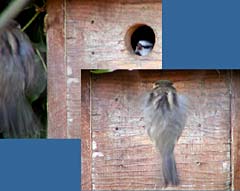
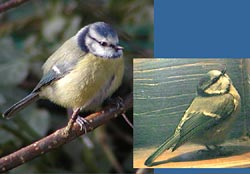
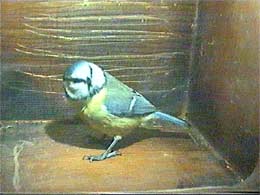 5
February - The camera
testing continues as the BT visits continue. As this picture
shows, the colour rendition is better with the LED torch in place,
although I will have to spend a bit more time dealing with the
brightness to avoid the 'washed-out' look on the BT's face.
5
February - The camera
testing continues as the BT visits continue. As this picture
shows, the colour rendition is better with the LED torch in place,
although I will have to spend a bit more time dealing with the
brightness to avoid the 'washed-out' look on the BT's face.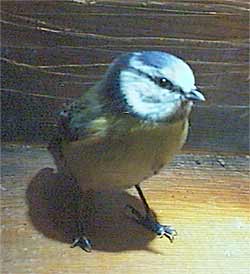 8
February - Over the
last couple of days there has not been much to report. Visits
have continued, although on the 6th they were less frequent.
8
February - Over the
last couple of days there has not been much to report. Visits
have continued, although on the 6th they were less frequent.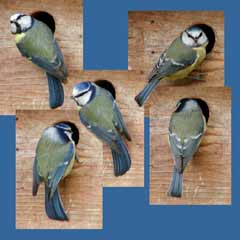
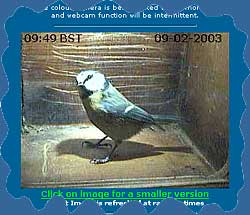 9
February - Last night
I sorted out the webcam software so that I could start testing
with the colour camera. The picture shows the first Blue Tit
image captured by the webcam this morning.
9
February - Last night
I sorted out the webcam software so that I could start testing
with the colour camera. The picture shows the first Blue Tit
image captured by the webcam this morning.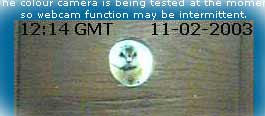 11
February - Webcam performance
has been intermittent today and I need to do some sorting out
to get it to be reliable.
11
February - Webcam performance
has been intermittent today and I need to do some sorting out
to get it to be reliable.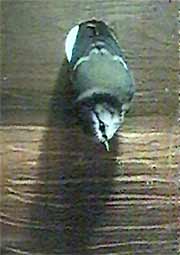 12
February - Again, on
a dull, damp day there were only a few visits that I saw, none
of which were captured by the webcam as far I as can tell.
12
February - Again, on
a dull, damp day there were only a few visits that I saw, none
of which were captured by the webcam as far I as can tell.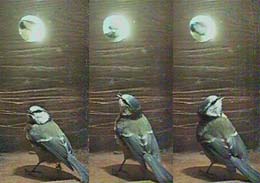 13
February - Another
quiet day, but a few more visits than yesterday, with at least
a couple caught on the webcam (which has behaved much better
today!).
13
February - Another
quiet day, but a few more visits than yesterday, with at least
a couple caught on the webcam (which has behaved much better
today!).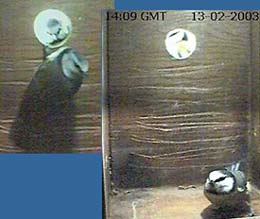
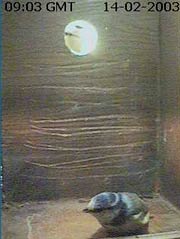 14
February - It may be
St. Valentine's Day, but when it comes to the birdbox, the male
knows his place - out! This webcam image captured the moment
when he was 'caught' inside by the female and went into his usual
crouch, leaving quickly as the female entered.
14
February - It may be
St. Valentine's Day, but when it comes to the birdbox, the male
knows his place - out! This webcam image captured the moment
when he was 'caught' inside by the female and went into his usual
crouch, leaving quickly as the female entered.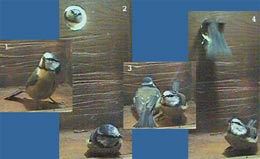
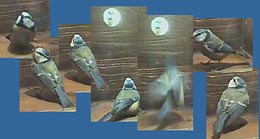
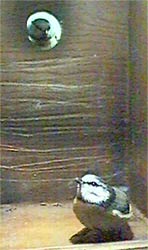 16
February - A quiet day, with just three visits recorded before
11am, although my failure to set up the video recorder meant
that the next three hours were missed while I was away from home.
16
February - A quiet day, with just three visits recorded before
11am, although my failure to set up the video recorder meant
that the next three hours were missed while I was away from home.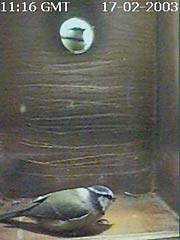 17
February - Things are pretty slow at the moment, with only
a small number of visits to the box each day. The picture shows
the male crouching as the female arrives. This time he left straight
away but she did not enter until a minute or two later.
17
February - Things are pretty slow at the moment, with only
a small number of visits to the box each day. The picture shows
the male crouching as the female arrives. This time he left straight
away but she did not enter until a minute or two later.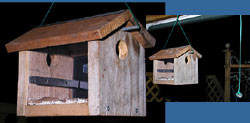
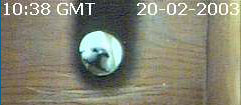
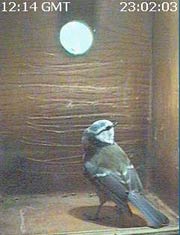 23
February - I have been
able to monitor the box for only short periods today, and other
than a number of 'faces at the entrance' this webcam image shows
the only time I saw a bird in the box.
23
February - I have been
able to monitor the box for only short periods today, and other
than a number of 'faces at the entrance' this webcam image shows
the only time I saw a bird in the box.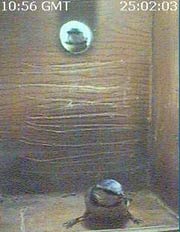 25
February - I am still
waiting for the first piece of straw to appear.
25
February - I am still
waiting for the first piece of straw to appear.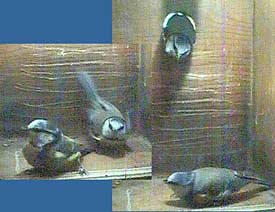 27
February - Still no
straw or moss, but the pair were quite active this morning, with
14 visits into the box before 2pm and numerous appearances at
the entrance.
27
February - Still no
straw or moss, but the pair were quite active this morning, with
14 visits into the box before 2pm and numerous appearances at
the entrance.